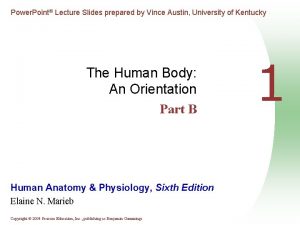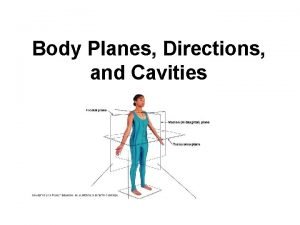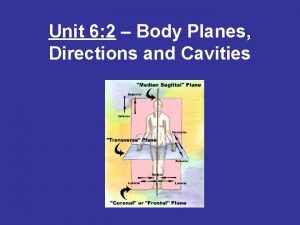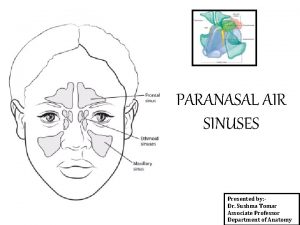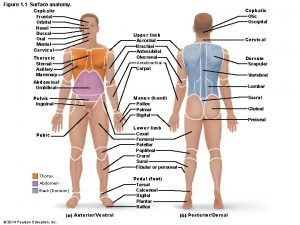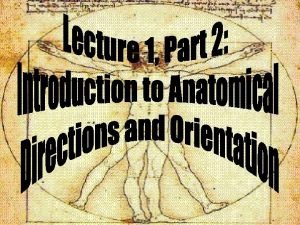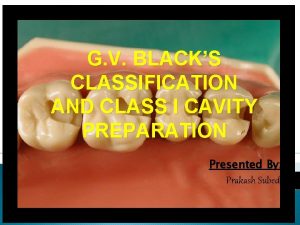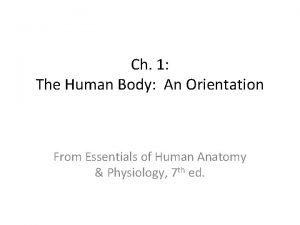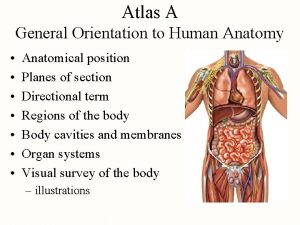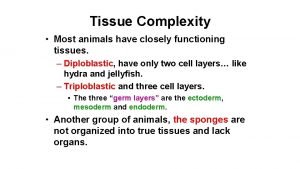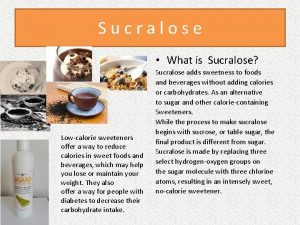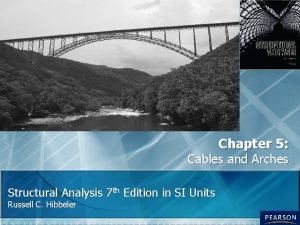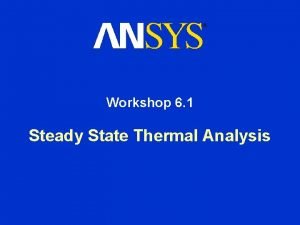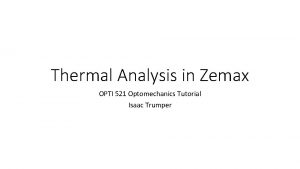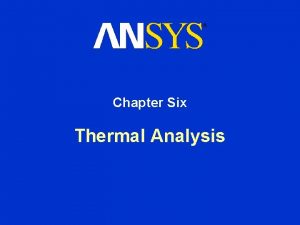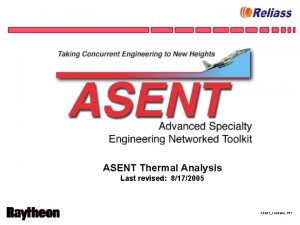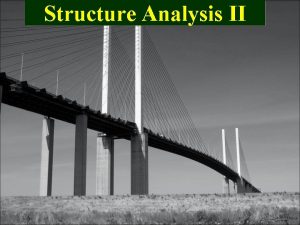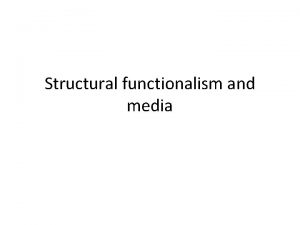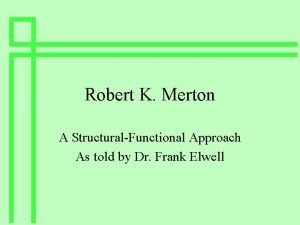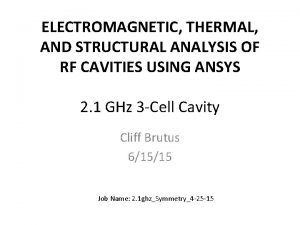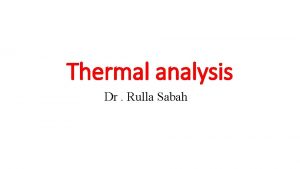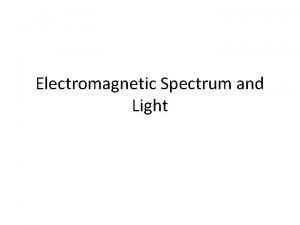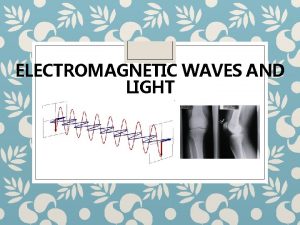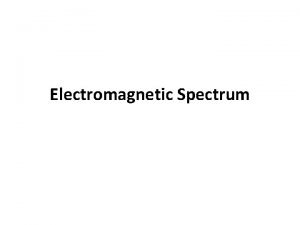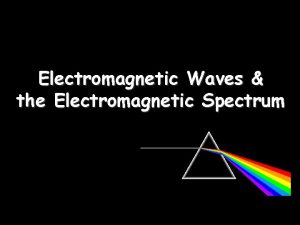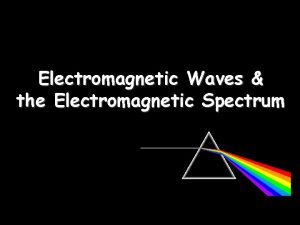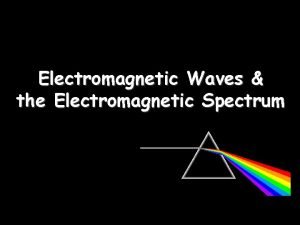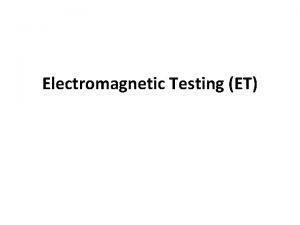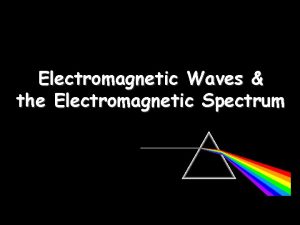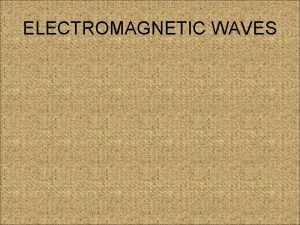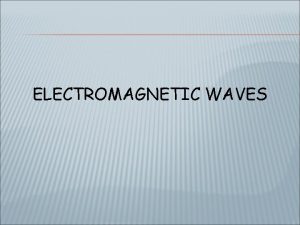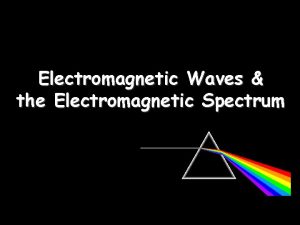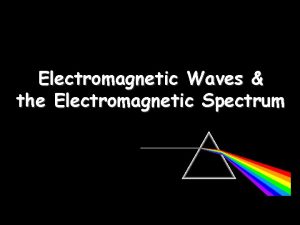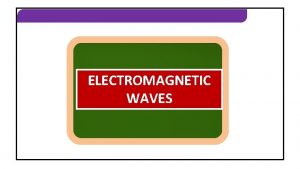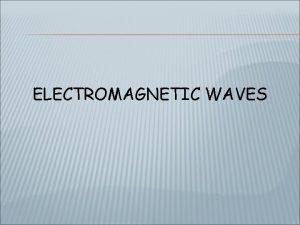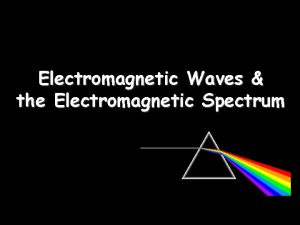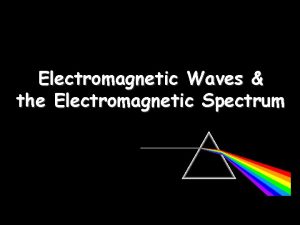ELECTROMAGNETIC THERMAL AND STRUCTURAL ANALYSIS OF RF CAVITIES





































- Slides: 37

ELECTROMAGNETIC, THERMAL, AND STRUCTURAL ANALYSIS OF RF CAVITIES USING ANSYS 2. 1 GHz 3 -Cell Cavity Cliff Brutus 7/9/15 Workbench Job Name: 2. 1 ghz_Symmetry_4 -25 -15 APDL Job Name: 2_1_ghz_apdl_6 -19 -15

Overall Layout Waveguide RF Window Arc Detector Viewport Cold Cathode Gauge Compact NEG and Ion Pump combination rec i D m Bea Field Probe Tuner Actuator

RF, Thermal and Structural Simulation CAD Model Thermal Analysis RF Analysis Structural Analysis

RF Analysis Full Model Symmetry • The cavity is not symmetric about its mid-plane since field probe port is on one side. • Model is simplified by removing all the flanges, bolts and some ports that are not needed in the analysis • Then the model is constructed to take advantage of the symmetry of the cavity about the beam axis

RF Analysis Frequency: 2114781678. 364 Hz CRITICAL AREAS: 0. 0008 m 6, 423, 586 Elements BODY AREAS: 0. 0015 m VOLUME: 0. 005 m • Regions near coupling slots, nose cones, waveguide and tuner are especially important for accurate frequency prediction üMesh density enhanced 6 x in this region • Maintains accuracy while keeping solution time convenient

RF Analysis Unselected surfaces for BC 284, 799 Nodes Electric Wall Areas

E-sum Nodal Solution 3. 509 E 6 V/m

H-sum Nodal Solution 1. 372 E 4 A/m

E-field along beam axis Ez path from -0. 146 m to 0. 207 m

Thermal Analysis • Must determine scaling factor for power dissipation -> used the integral of the E-field along the beam axis also the stored energy as a comparison • Thermal loads Scaling Factor = sqrt(U 250 k/Uansys) = 3902790. 61 üCalculated heat flux on walls from RF solution (H-field) üCooling channel convection HF = ½ * H 2 * R

ANSYS Freq. 2. 1147816 GHz U @ 250 KV 0. 0096875 J Epk 3. 509 E 6 V/m Hpk 1. 372 E 4 A/m Integ. Ez 280164. 1656 V Q-factor 13902. 0013 Est. Power Loss @ 200 KV = 5927. 630773 W Est. Power Loss @ 250 KV = 9261. 923084 W ANSYS APDL Total Est. Power Loss including Tuner 9261. 92 W ANSYS Workbench Total Est. Power Loss including Tuner 9413. 78 W Est. Power Loss on cavity surface 8728. 58 W Est. Power Loss on tuner 685. 2 W Est. Power Loss on window TBD W Workbench reaction: - 4706. 89 W for ½ model -342. 6 W >> For the window, Binping has not finish the design to move the window further away from the cavity. -2867. 7 W Scaling Factor = sqrt(U 250 k/Uansys) = 3902790. 61 -166. 83 W -202. 36 W -1127. 4 W

Nose Cone and Coupling Slots Cooling

Thermal Simulation 340. 2 K Worst Case Water Ambient Temperature : 305. 15 K # 8494 OD 15. 88 ID 9. 52 0. 625195 0. 374802019 x = y 3. 18 mm 0. 125196 0. 059055 in 3 GPM Flow h 12131 W/m^2 -K Velocity h = 13153 Dh=. 2634 Flow 1. 5 Velocity 8. 83 R 1. 5 8. 71 W/m^2 -K in GPM Ft/sc Ft/sec

Structural Simulation Fix Support Sliding and Rotating Support

Structural Simulation Without vacuum & displacement on one end Coupling Slots Sizing: 0. 0005 m Body sizing: 0. 001 m Axial thermal expansion: 0. 0043” Radial thermal expansion: 0. 0014” 9267 psi

Frequency Shift and Tuning 17562405 elements 23836406 nodes 9254748 elements 12963308 nodes

E-sum Nodal Solution

E-sum Nodal Solution

H-sum Nodal Solution

H-sum Nodal Solution

E-field along beam axis Ez path from -0. 146 m to 0. 207 m

RF Results ANSYS Freq. 2. 1154457 GHz U @ 250 KV 0. 0096875 J Est. Power Loss 9006. 96 W Epk @ 250 KV 4. 5751 E 6 V/m Hpk @ 250 KV 1. 6299 E 4 A/m Scaling Factor = U 250 k/Uansys = 0. 0096875/2*0. 273637 E-15 = 1. 770137079 E 13 Integ. Esum along Z 350005. 26 V @ 250 KV Q-factor 14296. 2845 Ez int 0. 8319 E-1

Thermal Simulation ! Surface power density scaling; scaling factor must be calculated sfscale, hflux, 1. 770137079 E 13

Thermal Simulation

Thermal Simulation 665. 5 C = 338. 65 K Worst Case Water Ambient Temperature : 305. 15 K # 8494 OD 15. 88 ID 9. 52 0. 625195 0. 374802019 x = y 3. 18 in 3 GPM h 12131 W/m^2 -K Velocity mp, kxx, 14, 401 !* Thermal Conductivity mm 0. 125196 0. 059055 Flow h = 13153 Dh=. 2634 Flow 1. 5 Velocity 8. 83 R 1. 5 8. 71 W/m^2 -K in GPM Ft/sc Ft/sec

Thermal Simulation 65. 5 C = 338. 65 K

Thermal Simulation 665. 5 C = 338. 65 K

Thermal Simulation 665. 5 C = 338. 65 K

Structural Simulation mp, ex, 15, 129. 8 E 9 !* Young's Modulus (Pa) copper mp, kxx, 15, 401 !* Thermal Conductivity mp, alpx, 15, 1. 77 e-5 !* Coefficient of Thermal Expansion mp, nuxy, 15, 0. 343 !* Poisson's Ratio Coupling Slots Sizing: 0. 0005 m Body sizing: 0. 001 m mp, ex, 15, 10 !* Young's Modulus (Pa) Vacuum Without vacuum & displacement on one end Radial thermal expansion: 0. 391 E-4 m = 0. 0015 ” Axial thermal expansion: 0. 15 E-3 m = 0. 0059”

Frequency Shift and Tuning 9254748 elements 12963308 nodes Frequency Shift = Ideal Shape Frequency – Steady State Deformed Shape Frequency =2115445725. 041 Hz – 2113456626. 968 Hz = 1989098. 073 Hz 5 MHz Tuning Range of tuner = 1. 989 MHz

E-sum Nodal Solution

E-sum Nodal Solution

H-sum Nodal Solution

H-sum Nodal Solution

RF Results ANSYS Freq. 2. 113456626 GHz U @ 250 KV 0. 0096875 J Est. Power Loss 8993. 06 W Epk @ 250 KV 4. 6045 E 6 V/m Hpk @ 250 KV 1. 6175 E 4 A/m Scaling Factor = U 250 k/Uansys = 0. 0096875/2*0. 273637 E-15 = 1. 738915814 E 13 Integ. Esum along Z 349828. 06 V @ 250 KV Q-factor 14304. 927 Ez int 0. 83891 E-1

2. 1 GHz Cavity

Thanks • • Silvia Verdu Andres Binping Xiao Chen Pai Steve Bellavia Chris Cullen Andrew Lambert (Berkley National Lab) Tom Schultheiss (AES)
 Section 3 using heat worksheet answers
Section 3 using heat worksheet answers Thermal transfer vs direct thermal printing
Thermal transfer vs direct thermal printing The anterior and posterior body cavities
The anterior and posterior body cavities Dorsal cavity
Dorsal cavity Fixed line of reference
Fixed line of reference Classification of body membranes
Classification of body membranes Two main body cavities
Two main body cavities Organs in left lower quadrant
Organs in left lower quadrant Body cavity quadrants
Body cavity quadrants The midsagittal plane divides the body into
The midsagittal plane divides the body into Body cavity
Body cavity Jhuma biswas homeopathy
Jhuma biswas homeopathy Air containing cavities in the bones around the nose
Air containing cavities in the bones around the nose Frontal anatomy
Frontal anatomy Body cavities labeled
Body cavities labeled Anatomical position palms face
Anatomical position palms face Larynx cervical level
Larynx cervical level Gv black's classification
Gv black's classification Echinoderm body cavity
Echinoderm body cavity The brain contains four lined cavities called
The brain contains four lined cavities called Body cavities
Body cavities Body orientation definition
Body orientation definition Major body cavities
Major body cavities Animal body cavities
Animal body cavities Ventral cavity
Ventral cavity Body cavities
Body cavities What is sweeteners
What is sweeteners Arches and cables structural analysis
Arches and cables structural analysis What is steady-state thermal analysis?
What is steady-state thermal analysis? Factors affecting tga
Factors affecting tga Opti 521
Opti 521 Dta dsc
Dta dsc What is steady-state thermal analysis?
What is steady-state thermal analysis? Thermal analysis ppt
Thermal analysis ppt Differential thermal analysis
Differential thermal analysis Virtual work method truss
Virtual work method truss What is structural functionalism
What is structural functionalism Structural functional analysis is given by
Structural functional analysis is given by


